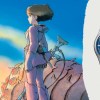Professional artist sheds light on Studio Ghibli’s unusual take on artistic perspective in the famous anime, but is it really a big deal?
Think back to High School Art 101 (if you had it). One of your lessons likely included an introduction to linear perspective, which is a technique used to create the illusion of our 3-D world on a 2-D page. In a one-point perspective drawing, imaginary vanishing lines along an object recede to one vanishing point on an imaginary horizon line (in this case, think “eye-level line”) in the distance. Accordingly, the object diminishes in size as it gets closer to the vanishing point.
▼ Sample one-point perspective drawings–classic examples include a road or railroad tracks stretching into the distance.
https://twitter.com/JackieSHoughton/status/688143092436697088On the other hand, a two-point perspective drawing utilizes two vanishing points on a horizon line and therefore two sets of vanishing lines to create the illusion of depth and space on an object viewed from an angle.
▼ Sample two-point perspective drawings–a classic example is depicting the corner of a building.
Fabulous two-point perspective drawings from our level 2 Art & Design students #art #drawing #architecture #perspective #angles #3D #studentwork pic.twitter.com/GjukgIxwSC
— City College (@city_college) March 20, 2018
Linear perspective is a basic artistic skill that’s taught even in junior high school (as depicted above), so its use should be a no-brainer for seasoned professional artists…right?
Manga artist Ikku Masa, best known for the Sakura Wars manga adaptation, recently raised an interesting question about the artistic technique used by a little animation house known as Studio Ghibli (you may have heard of them before):
透視図法といえば、学生の頃、トトロのレイアウトに定規を当てたら一点透視のはずなのに消失点が2つあって、これはどういうことなのかとかなり悩んだ記憶がある pic.twitter.com/aaJyuM3kRE
— 政一九 (@Masa_Ikku) May 28, 2019
“Speaking of perspective drawings, when I was a student I applied a ruler to a scene from My Neighbor Totoro. Even though it was supposed to be a one-point perspective drawing there were actually two vanishing points. I remember really worrying about what this meant.”
The still is taken from My Neighbor Totoro, Studio Ghibli’s 1988 classic film directed by the legendary Hayao Miyazaki. It features sisters Satsuki and Mei running excitedly through their new house into an empty tatami room. As Masa demonstrates by actually adding sample imaginary vanishing lines to the one-point perspective drawing, the lines don’t neatly converge at a single vanishing point according to the rules of linear perspective but instead converge at two vanishing points. What’s going on here?
Dozens of net users weighed in on the issue, including some other artists. The following is a selection of some of the discussion that was sparked regarding the technicalities of linear perspective:
Twitter user @yanamosuda:
最近だとスパイダーバースでもパースをズラす手法が使われていましたね。
— 弥奈モス田/Yanamosuda (@yanamosuda) May 28, 2019
正確過ぎるパースは視線誘導の妨げになるんだと思います。
絵は誇張表現ですが、パースも誇張して良いんですね。
“Recently the technique to shift perspective has even been used in ‘Spider-Man: Into the Spider-Verse. I think it’s because when perspective is done too accurately it obstructs our line of sight. The picture becomes an exaggerated representation, but it’s good to exaggerate perspective, too.”
Manga artist @suzuki_kenya:
これについては「宮崎アニメの背景には消失点がない」「消失点を点でなく円で取ってる」みたいな話を聞くけど、一番わかりやすいのは湖川友謙さんのアニメーション作画法にある「二支点透視画法」かな。絵の支点を複数置くことで意図的に錯覚現象を起こし空間を広く見せてる。https://t.co/KZVzvXf0JC
— 鈴木健也 (@suzuki_kenya) May 28, 2019
“I often hear things like ‘There’s no vanishing point in the background of Miyazaki anime’ or ‘The vanishing point is not a dot but a circle.’ However, I believe the easiest thing to understand is the ‘two-fulcrum perspective technique’ found in Tomonori Kogawa [a veteran animator]’s drawings. By placing multiple fulcrums in the picture you can create an intentional optical illusion to display space widely.”
Twitter user @Hidari_ShinnosK:
持論ですが、何故2点の方が自然かというと、人間の受像は一点透視画像2つ(両目)の合成だから。左視野は右脳、右視野は左脳で処理されます。
— 左紳之介 (@Hidari_ShinnosK) May 28, 2019
この合成像を1枚の絵にする時、2点の中間にもう1点必要。絵の真中を奥へ伸びる直線線路等を描く時はその中央点に収束させますhttps://t.co/DIN05j5Zmb
“It’s just my theory, but I think the reason why the two vanishing points seems more natural is because human visual perception is ultimately a composite due to our binocular vision. Your left field of vision is governed by the right side of the brain and your right field of vision is governed by the left side of the brain. When putting this composite into a single drawing, one more point is necessary halfway between the two. When drawing straight lines or the like that extend into the center of the picture, you make them converge at that central point.”
Masa replied to the previous post by posing a new question of his own:
では片目で景色を見るとどうなるでしょうか?
— 政一九 (@Masa_Ikku) May 29, 2019
僕は「人の視線は無意識に動いていて、それにつれて刻々と変わるパースの変化を脳内で補正しているから」だと思います。
“In that case what happens if you use only one eye to view it? I believe that a person’s line of sight operates unconsciously and along with that the change in perspective is corrected moment by moment within the brain.”
Three participants in the discussion offered up visual aids to support different theories or as added illustrations of the phenomenon:
ロッカールームを例に縦2点の場合を図にしてみました。こんな理解で良いでしょうか? pic.twitter.com/XFgNT1adIm
— 左紳之介 (@Hidari_ShinnosK) May 29, 2019
“Using a locker room as an example I’ve made a diagram of two vertical vanishing points. Is this helpful for understanding?
Upper left corner panel: one-point perspective
Upper right corner panel: two-point perspective
Lower left corner panel: theory that there are two points because it’s a composite of several images you see when your eyeballs and neck move (your line of sight unconsciously moves)
Lower right corner panel: theory that there are two points due to parallex overlapping of the two eyes (the composite section). The left and right images each converge respectively.”
実際に3DCGでどうやるんだ?って話しなんですが、モデル全体にデフォーム(テーパー)をかけます。良い例とは言えないんですが、消失点が1つと消失点が2つになるCG画像の参考例を作ってみました。 pic.twitter.com/N4c5CJFXLd
— Yoshiteru Enomoto (@eno1963) May 28, 2019
“To see how this actually works in a 3-D CG rendering, I’ve applied deformation (tapering) to the whole model. I can’t say they’re great, but here are sample CG reference images with only one vanishing point and two vanishing points.”
手元の構図法の本にヴェロネーゼの例が出てました。 pic.twitter.com/zgCfG9iX7Y
— HIKARV (@HIKARV3) May 28, 2019
“I found an example by Paolo Veronese [Italian Renaissance painter] in a composition book I had on hand.”
Net users who didn’t participate in the technical discussion still enjoyed leaving their own impressions and thoughts on the matter, too.
“I get it, I get it…I have no idea what you’re talking about.”
“There’s another vanishing point for the tatami.”
“I used to agonize over this when I was a manga assistant. All of the manga artist’s rough sketches had two vanishing points. When I tried to turn them into one vanishing point the image always changed in some way. That’s how I learned not to make too much of a fuss over vanishing points.”
“There are other Ghibli works with this false perspective as well. It’s all in order to fit everything in the scene in cleanly and to emphasize the beauty of the composition.”
“He’s said before something like ‘Princess Mononoke was also produced in this way. One-point perspective is an illusion developed by Westerners. It’s fine for me to draw using two vanishing points.”
“I support the theory that there was supposed to be one vanishing point but Satsuki grabbed it and moved it.”
If we had to go with one theory, the Satsuki-snatching one directly above seems pretty convincing, if you ask us. It seems that regardless of the reasoning behind Ghibli’s (un)intentional breaking of the rules of perspective in this scene and others, general viewers seem to be less concerned about the technical side of things and more concerned about simply enjoying the film.
Source: Twitter/@Masa_Ikku via Hachima Kiko
Featured image: Twitter/@Masa_Ikku
● Want to hear about SoraNews24’s latest articles as soon as they’re published? Follow us on Facebook and Twitter!

 My Neighbor Totoro, Castle in the Sky kitchens to be recreated in life-size at Ghibli Museum
My Neighbor Totoro, Castle in the Sky kitchens to be recreated in life-size at Ghibli Museum Studio Ghibli producer shows us how to draw Totoro【Video】
Studio Ghibli producer shows us how to draw Totoro【Video】 Official My Neighbor Totoro cookbook teaches you to make Satsuki’s bento and other Ghibli meshi
Official My Neighbor Totoro cookbook teaches you to make Satsuki’s bento and other Ghibli meshi Luxury Spanish leather designer Loewe releases limited edition My Neighbor Totoro collection
Luxury Spanish leather designer Loewe releases limited edition My Neighbor Totoro collection Chinese poster for Totoro’s first theatrical release in country has a beautifully subtle secret
Chinese poster for Totoro’s first theatrical release in country has a beautifully subtle secret Hayao Miyazaki says Happy New Year to Studio Ghibli fans with new art for Year of the Horse
Hayao Miyazaki says Happy New Year to Studio Ghibli fans with new art for Year of the Horse New Inuyasha figures are always adorably sitting, even if you don’t tell them “Osuwari!”【Pics】
New Inuyasha figures are always adorably sitting, even if you don’t tell them “Osuwari!”【Pics】 7 great places to see Mt. Fuji from without having to climb it
7 great places to see Mt. Fuji from without having to climb it Check out this 8m robot that appeared on Tokyo’s waterfront【Video】
Check out this 8m robot that appeared on Tokyo’s waterfront【Video】 Japan’s Self-Defense Forces take “radio calisthenics” to an interesting new level
Japan’s Self-Defense Forces take “radio calisthenics” to an interesting new level “Bear” voted Japan’s Kanji of the Year for 2025 in extremely close race
“Bear” voted Japan’s Kanji of the Year for 2025 in extremely close race Posthumous “Gwegh, I’m deadngo” tweet sparks nationwide cancer awareness movement in Japan
Posthumous “Gwegh, I’m deadngo” tweet sparks nationwide cancer awareness movement in Japan We found possibly the quietest Japanese-style hotel in Tokyo’s bustling Shinjuku district
We found possibly the quietest Japanese-style hotel in Tokyo’s bustling Shinjuku district More people in Japan quit sending New Year’s cards and many have started to regret it
More people in Japan quit sending New Year’s cards and many have started to regret it Studio Ghibli’s Nausicaa of the Valley of the Wind becomes wristwatch of Seiko【Photos】
Studio Ghibli’s Nausicaa of the Valley of the Wind becomes wristwatch of Seiko【Photos】 Starbucks Japan ready to get Year of the Horse started with adorable drinkware and plushies【Pics】
Starbucks Japan ready to get Year of the Horse started with adorable drinkware and plushies【Pics】 7-Eleven Japan’s ramen-cooking robot whipped us up a bowl of noodles【Taste test】
7-Eleven Japan’s ramen-cooking robot whipped us up a bowl of noodles【Taste test】 Cyberpunk anime meets traditional culture in Ghost in the Shell gold leaf Japanese changing screens
Cyberpunk anime meets traditional culture in Ghost in the Shell gold leaf Japanese changing screens Hello Kitty Choco Egg figures are an adorable trip through three periods of Japanese pop culture【Pics】
Hello Kitty Choco Egg figures are an adorable trip through three periods of Japanese pop culture【Pics】 Japan’s otoshidama tradition of giving kids money at New Year’s gets a social welfare upgrade
Japan’s otoshidama tradition of giving kids money at New Year’s gets a social welfare upgrade Lacquerware supplier to emperor of Japan and Pokémon team up for new tableware
Lacquerware supplier to emperor of Japan and Pokémon team up for new tableware Sumo Sanrio! Hello Kitty and pals team up with Japan Sumo Association for new merch【Pics】
Sumo Sanrio! Hello Kitty and pals team up with Japan Sumo Association for new merch【Pics】 Can a dirty butthole make you filthy rich in Japan? We’re starting a New Year’s lottery experiment
Can a dirty butthole make you filthy rich in Japan? We’re starting a New Year’s lottery experiment 7-Eleven Japan starts new temporary luggage storage service in over 300 branches
7-Eleven Japan starts new temporary luggage storage service in over 300 branches Disillusionment at Tsukiji’s tourist-target prices led us to a great ramen restaurant in Tokyo
Disillusionment at Tsukiji’s tourist-target prices led us to a great ramen restaurant in Tokyo Starbucks teams up with 166-year-old Kyoto doll maker for Year of the Horse decorations【Photos】
Starbucks teams up with 166-year-old Kyoto doll maker for Year of the Horse decorations【Photos】 Tokyo considering law requiring more trash cans following litter increase in heavily touristed area
Tokyo considering law requiring more trash cans following litter increase in heavily touristed area Tokyo’s Tsukiji sushi neighborhood asks tour groups to stay away for the rest of the month
Tokyo’s Tsukiji sushi neighborhood asks tour groups to stay away for the rest of the month Nintendo’s Kirby now delivering orders at Kura Sushi restaurants, but not in Japan
Nintendo’s Kirby now delivering orders at Kura Sushi restaurants, but not in Japan Tokyo event lets you travel back in time, for free, to celebrate 100 years since Showa era start
Tokyo event lets you travel back in time, for free, to celebrate 100 years since Showa era start Sanrio theme park in Japan announces plans to expand into a Sanrio resort
Sanrio theme park in Japan announces plans to expand into a Sanrio resort Japan may add Japanese language proficiency, lifestyle classes to permanent foreign resident requirements
Japan may add Japanese language proficiency, lifestyle classes to permanent foreign resident requirements Survey asks foreign tourists what bothered them in Japan, more than half gave same answer
Survey asks foreign tourists what bothered them in Japan, more than half gave same answer Japan’s human washing machines will go on sale to general public, demos to be held in Tokyo
Japan’s human washing machines will go on sale to general public, demos to be held in Tokyo Japan’s deadliest food claims more victims, but why do people keep eating it for New Year’s?
Japan’s deadliest food claims more victims, but why do people keep eating it for New Year’s? We deeply regret going into this tunnel on our walk in the mountains of Japan
We deeply regret going into this tunnel on our walk in the mountains of Japan Studio Ghibli releases Kodama forest spirits from Princess Mononoke to light up your home
Studio Ghibli releases Kodama forest spirits from Princess Mononoke to light up your home Major Japanese hotel chain says reservations via overseas booking sites may not be valid
Major Japanese hotel chain says reservations via overseas booking sites may not be valid Put sesame oil in your coffee? Japanese maker says it’s the best way to start your day【Taste test】
Put sesame oil in your coffee? Japanese maker says it’s the best way to start your day【Taste test】 No more using real katana for tourism activities, Japan’s National Police Agency says
No more using real katana for tourism activities, Japan’s National Police Agency says Starbucks Japan reveals new sakura drinkware collection, inspired by evening cherry blossoms
Starbucks Japan reveals new sakura drinkware collection, inspired by evening cherry blossoms Updated cherry blossom forecast shows extra-long sakura season for Japan this year
Updated cherry blossom forecast shows extra-long sakura season for Japan this year Book of over 200 Hayao Miyazaki Totoro pre-production illustrations, some never published, now on sale
Book of over 200 Hayao Miyazaki Totoro pre-production illustrations, some never published, now on sale Live-action My Neighbor Totoro stage play starts this fall, composer Joe Hisaishi producing【Vid】
Live-action My Neighbor Totoro stage play starts this fall, composer Joe Hisaishi producing【Vid】 Studio Ghibli reveals surprising secrets hidden in My Neighbour Totoro
Studio Ghibli reveals surprising secrets hidden in My Neighbour Totoro Official Studio Ghibli x Pixar image causes a buzz online
Official Studio Ghibli x Pixar image causes a buzz online Ghibli Museum entrance is actually…the Catbus?!
Ghibli Museum entrance is actually…the Catbus?! Studio Ghibli creates gorgeous hand-made Totoro reproduction cels for fans and collectors【Video】
Studio Ghibli creates gorgeous hand-made Totoro reproduction cels for fans and collectors【Video】 Studio Ghibli releases 250 more free-to-download/use images from five films, and Totoro is here!
Studio Ghibli releases 250 more free-to-download/use images from five films, and Totoro is here!
Leave a Reply